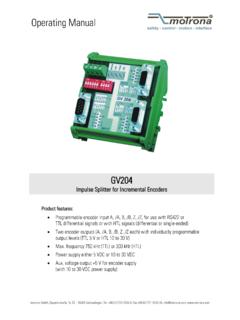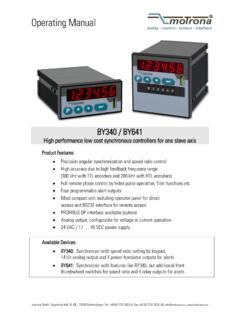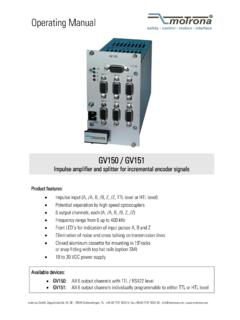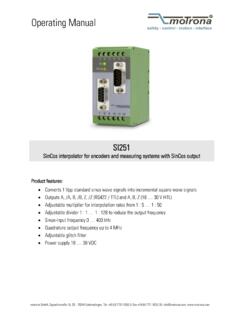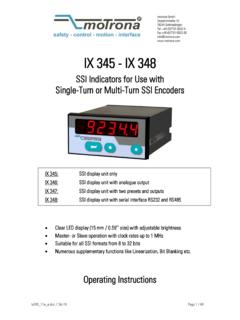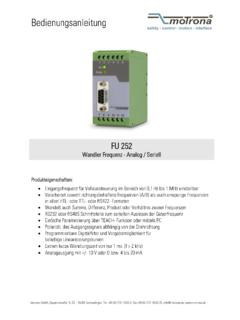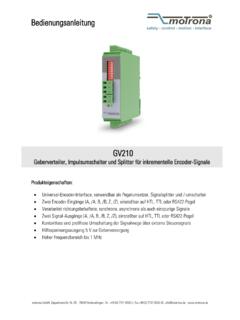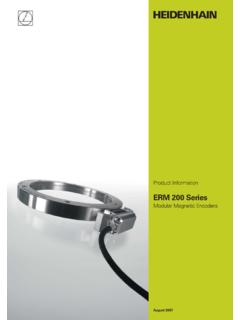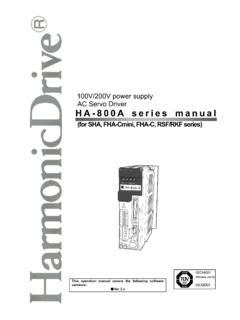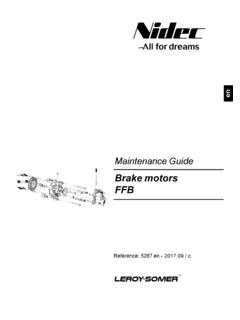Transcription of FS150 - motrona
1 / Nov-15 Page 1 / 59 FS150 High Performance Flying Shear Control m o ro na Stand alone controller for Cut on the fly applications Can operate with Servo- or DC- or AC- inverter drives High accuracy, 300 kHz input frequency Highly dynamic, 150 sec response time Easy remote length preset by thumbwheel switches or PLC or host computer Easy LCD display setting or PC setting via serial link RS232/RS485 and CANopen interface Speed transitions by sin profile. Speed variable anticipation for carriage start. Print mark registration and batch counters included. Operating instructions / Nov-15 Page 2 / 59 Safety instructions This manual is an essential part of the unit and contains important hints about function, correct handling and commissioning. Non-observance can result in damage to the unit or the machine or even in injury to persons using the equipment! The unit must only be installed, connected and activated by a qualified electrician It is a must to observe all general and also all country-specific and application-specific safety standards When this unit is used with applications where failure or maloperation could cause damage to a machine or hazard to the operating staff, it is indispensable to meet effective precautions in order to avoid such consequences Regarding installation, wiring, environmental conditions, screening of cables and earthing, you must follow the general standards of industrial automation industry - Errors and omissions excepted Version: Description: FS15016N/ TJ/ Oct.
2 03/ Page/21/26/42 Max. 8 print marks between sensor and home position Control word and status word Encoder inputs levels and max. frequency FS15016C_d/Bo/Jul-08 Modification to motrona format / Nov-15 Page 3 / 59 Table of Contents 1. Introduction .. 5 2. Principle of Operation .. 6 3. Hardware Configuration .. 7 4. Wiring and Screening .. 9 Encoders .. 11 Analogue Output .. 13 Power Supply .. 14 Parallel Interface (PI) .. 14 5. Control IN / OUT Port (PI/PO) .. 17 6. The Serial Port .. 20 7. Register settings .. 22 8. How to operate the Keypad .. 23 9. The Data IN Menu .. 26 10. Setup Menu .. 33 11. Adjust Menu .. 35 12. Testprog Menu .. 35 13. The LED Display .. 36 14. Remarks about Drives, Encoders, Cables, Installation .. 37 15. Steps for commissioning .. 39 16. Alarm States and Conditions .. 46 17. Accuracy considerations .. 47 18. Which shortest length can we cut at a certain line speed? .. 49 19.
3 Which maximum line speed can we use with a certain cutting length .. 50 20. Which travelling distance does our carriage need? .. 50 21. Auxiliary Register and Command Codes .. 51 22. General Master Reset and Erase of EEProm .. 53 23. The BY 106-X Remote Thumbwheel Switch .. 54 24. Dimensions and Specifications .. 55 25. Serial Code List .. 57 Parameter .. 57 Inputs .. 58 Variables .. 59 / Nov-15 Page 4 / 59 Compatibility Hint Versions FS15014A and higher use some different control inputs and control outputs and therefore are not fully hardware compatible to former versions! You must modify a few connections at the PI/PO connector when replacing older version against FS15014A or a higher version! See section 5. The software has been upgraded and now includes Batch counters for total quantity, waste quantity, total length Registers for actual line speed, carriage speed, synchronizing error etc. 3 software limit switches to protect against carriage overshoot.
4 No more proximity for extreme carriage positions necessary. Real acceleration settings instead of ramp times Virtual master axis with adjustable simulation speed Impulse output with scaling facility for material line Correction register for easy compensation of slip of the measuring wheel Enhanced setup tools in the OS30 operator software, including scope functions, providing still easier commissioning procedures. Improved S- shape profile for still higher cutting efficiency. / Nov-15 Page 5 / 59 1. Introduction Flying shears are used for cutting applications, where endless material to be cut to length cannot be stopped during the cutting process and the cut must be effected on the fly . The mechanical construction provides a saw or shear system mounted on a carriage, that follows the material with synchronous speed while cutting is in progress, and then returns to a home position to wait for the next cut.
5 See schematics on title page. The FS flying shear control is based on a BY150 synchronizer system. The software has been designed for the special requirements of flying shears under consideration of maximum efficiency and accuracy at minimum stress for all mechanical parts. Only a few registers must be set in order to adapt the controller to the mechanical and electrical specifications of the shear system. A small keypad with LCD provides easy setup, but also a disc with operator software is included for easy PC setup of the controller. All essential registers like cutting length, tool width etc. are also accessible by parallel interface, providing easy setting by remote BCD thumbwheel switch or PLC parallel output. The unit uses a closed 19 steel cassette for maximum EMC protection. With option SM150, the housing can also be mounted on DIN rails. / Nov-15 Page 6 / 59 2. Principle of Operation The shear (or saw blade) is fixed on a carriage that can move forward and reverse under control of a +/- 10V speed reference voltage of the carriage drive.
6 Normally, a 4 quadrant DC or servo drive is used. For lower requirements in performance, the FS150 unit can also control 1-quadrant AC drives using a positive speed reference signal and two outputs for forward/reverse select. The FS150 controller counts the length from the line encoder (feed roll or measuring wheel) while the carriage is held in its rear home position. Once the cutting position approaches, the carriage accelerates and synchronizes with the line. A "Ready to cut" signal is generated in order to start the cutting process, while the shear moves fully synchronous with the cutting position on the material. When the cut is completed, the FS150 must receive a "cut complete" signal. This will cause a deceleration and a reversal of the carriage until it has reached its home position again. All speed transitions occur with a smooth sin speed profile for absolutely careful treatment of screws and other mechanicals parts.
7 CutVVLLi ne speedSpe ed prof ilet Fig 1 The FS150 control continuously measures the line speed and calculates an anticipation value to start the carriage before the cutting length is reached. Thus the shear will exactly match the cutting position of the material upon completion of the acceleration ramp and no over swing or oscillation will take place prior to the cut. This saves time and increases the cutting efficiency of the shear system considerably. / Nov-15 Page 7 / 59 3. Hardware Configuration As a master drive, mostly the motor of a feed roll is used. The "master" can also be a measuring wheel equipped with an incremental encoder. The encoder resolution should be at least 5 times higher than the maximum acceptable cutting error. Quadrature encoders (TTL-types A, /A, B, /B) must be used. Where you find you must use HTL encoders (10 30 V, A and B output), please apply our level converter type PU210 to generate the proper RS422 signals required.
8 Digital feed forward technology needs a certain minimum frequency: At maximum line speed, the master encoder frequency should be at least a few hundred Hertz. It is best to choose the ppr numbers of line and carriage encoders in a way to produce frequencies in the same range. It is necessary to adjust the slave to its maximum dynamic response (no internal ramps, no integral control loop, high proportional gain etc.) because the FS150 will generate ramps to which the drive must follow with no additional delay. A signal must be available to indicate completion of a cut to the FS150 controller. All control signals must be PNP (switching to positive) with a level of volts DC. Fig. 2 shows the block diagram of the unit. / Nov-15 Page 8 / 59 CarriageEncoder+/-10V(or +10V)Analogue-outputSlaveInputMasterInpu tA, /A, B, /BA, /A, B, /BPower24 VDCRS232 ReadyReverseLengthCarriage AlarmHome positionGap to cutParallelData InputResetJog PIStart GapCut CompletedStore EEPromStart/StopImmediate CutLenght 1 / Length 2 Zero PositionDec CounterRS485 CANFS150 ControlInputsCommuni-cationPortsOutputsM easuring wheelLine-EncoderPLC orBCD switchBold printed connectionsare must Other connectionsare can Carriage driveForward*)Virtual line OnWith 1 Q drives only*) Fig 2 For safety reasons, we strictly recommend to limit the travelling range by mechanical limit switches at both ends in order to avoid damage with carriage overshoot upon failure of the electronic control system!
9 / Nov-15 Page 9 / 59 4. Wiring and Screening Serial RS232(Sub-D-9- female)Parallel Interface(Sub-D-25- male)Control IN/Out(Sub-D-25- female)Analogue Out(Sub-D-9- female)Carriage encoder(Sub-D-9- male)Line encoder(Sub-D-9- male)24 VDCS upplyCAN BusMaster ResetbuttonLEDbargraphPE (Grounding screw) For reasons of proper screening, it is a must to follow the subsequent instructions . Where you don t exactly observe these grounding and screening rules, it is almost for sure that you will have problems later! a. The minus wire of the power supply must be connected to the grounding screw on the front plate of the FS150 controller with a short wire of at least mm . On site of the power supply, the minus output must be earthed. Where the wires between power unit and FS150 controllers are longer than 1 meter, it is advisable to ground the front plate of the controller again by a separate wire, on the shortest way possible.
10 +24 VFs150 Supplement short earthing when power cable is longPower SupplyPE Fig 4 / Nov-15 Page 10 / 59 b. All screens on the controller side must be connected to the housing of the corresponding Sub-D-connector. This is valid for encoder cables, analogue output and PI or PO lines. Where you use Sub-D-connectors with a plastic housing, you must solder the screen to the metallic frame of the connector. At any time you must be sure the screen gets a proper contact to the front fascia of the unit when connected to the controller. Screen Fig 5 c. When encoder cables are interrupted by terminal boxes or intermediate connectors on their way from the controller to the encoder, you must connect the screen to the Minus wire of the encoder supply there, but never to earth potential again! to encoderEncoder cableto FS150 Minus of encoder supplyScreenTie Minus of encoder supply and screen together whereever you interrupt the encoder cable by terminal or sure the screen can never get any earth potential here!
